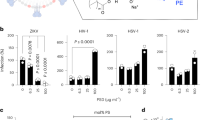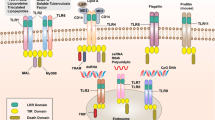Abstract
Erythrocyte invasion by Plasmodium falciparum is central to the pathogenesis of malaria. Invasion requires a series of extracellular recognition events between erythrocyte receptors and ligands on the merozoite, the invasive form of the parasite. None of the few known receptor–ligand interactions involved1,2,3,4 are required in all parasite strains, indicating that the parasite is able to access multiple redundant invasion pathways5. Here, we show that we have identified a receptor–ligand pair that is essential for erythrocyte invasion in all tested P. falciparum strains. By systematically screening a library of erythrocyte proteins, we have found that the Ok blood group antigen, basigin, is a receptor for PfRh5, a parasite ligand that is essential for blood stage growth6. Erythrocyte invasion was potently inhibited by soluble basigin or by basigin knockdown, and invasion could be completely blocked using low concentrations of anti-basigin antibodies; importantly, these effects were observed across all laboratory-adapted and field strains tested. Furthermore, Oka− erythrocytes, which express a basigin variant that has a weaker binding affinity for PfRh5, had reduced invasion efficiencies. Our discovery of a cross-strain dependency on a single extracellular receptor–ligand pair for erythrocyte invasion by P. falciparum provides a focus for new anti-malarial therapies.
This is a preview of subscription content, access via your institution
Access options
Subscribe to this journal
Receive 51 print issues and online access
$199.00 per year
only $3.90 per issue
Buy this article
- Purchase on Springer Link
- Instant access to full article PDF
Prices may be subject to local taxes which are calculated during checkout



Similar content being viewed by others
Change history
21 December 2011
The Competing Financial Interests statement appeared incorrectly in the AOP PDF version. This has been corrected.
References
Maier, A. G. et al. Plasmodium falciparum erythrocyte invasion through glycophorin C and selection for Gerbich negativity in human populations. Nature Med. 9, 87–92 (2003)
Mayer, D. C. et al. Glycophorin B is the erythrocyte receptor of Plasmodium falciparum erythrocyte-binding ligand, EBL-1. Proc. Natl Acad. Sci. USA 106, 5348–5352 (2009)
Sim, B. K. et al. Receptor and ligand domains for invasion of erythrocytes by Plasmodium falciparum. Science 264, 1941–1944 (1994)
Tham, W. H. et al. Complement receptor 1 is the host erythrocyte receptor for Plasmodium falciparum PfRh4 invasion ligand. Proc. Natl Acad. Sci. USA 107, 17327–17332 (2010)
Cowman, A. F. & Crabb, B. S. Invasion of red blood cells by malaria parasites. Cell 124, 755–766 (2006)
Baum, J. et al. Reticulocyte-binding protein homologue 5 – an essential adhesin involved in invasion of human erythrocytes by Plasmodium falciparum. Int. J. Parasitol. 39, 371–380 (2009)
Iyer, J. et al. Invasion of host cells by malaria parasites: a tale of two protein families. Mol. Microbiol. 65, 231–249 (2007)
Hayton, K. et al. Erythrocyte binding protein PfRH5 polymorphisms determine species-specific pathways of Plasmodium falciparum invasion. Cell Host Microbe 4, 40–51 (2008)
Rodriguez, M. et al. PfRH5: a novel reticulocyte-binding family homolog of Plasmodium falciparum that binds to the erythrocyte, and an investigation of its receptor. PLoS ONE 3, e3300 (2008)
Pasini, E. M. et al. In-depth analysis of the membrane and cytosolic proteome of red blood cells. Blood 108, 791–801 (2006)
Bushell, K. M. et al. Large-scale screening for novel low-affinity extracellular protein interactions. Genome Res. 18, 622–630 (2008)
Martin, S. et al. Construction of a large extracellular protein interaction network and its resolution by spatiotemporal expression profiling. Mol. Cell. Proteomics 9, 2654–2665 (2010)
Söllner, C. & Wright, G. J. A cell surface interaction network of neural leucine-rich repeat receptors. Genome Biol. 10, R99 (2009)
Spring, F. A. et al. The Oka blood group antigen is a marker for the M6 leukocyte activation antigen, the human homolog of OX-47 antigen, basigin and neurothelin, an immunoglobulin superfamily molecule that is widely expressed in human cells and tissues. Eur. J. Immunol. 27, 891–897 (1997)
Igakura, T. et al. A null mutation in basigin, an immunoglobulin superfamily member, indicates its important roles in peri-implantation development and spermatogenesis. Dev. Biol. 194, 152–165 (1998)
Fadool, J. M. & Linser, P. J. 5A11 antigen is a cell recognition molecule which is involved in neuronal-glial interactions in avian neural retina. Dev. Dyn. 196, 252–262 (1993)
Wright, G. J. Signal initiation in biological systems: the properties and detection of transient extracellular protein interactions. Mol. Biosyst. 5, 1405–1412 (2009)
Williams, B. P. et al. Biochemical and genetic analysis of the Oka blood group antigen. Immunogenetics 27, 322–329 (1988)
Guo, H. et al. Stimulation of matrix metalloproteinase production by recombinant extracellular matrix metalloproteinase inducer from transfected Chinese hamster ovary cells. J. Biol. Chem. 272, 24–27 (1997)
Anstee, D. J. The nature and abundance of human red cell surface glycoproteins. J. Immunogenet. 17, 219–225 (1990)
Theron, M., Hesketh, R. L., Subramanian, S. & Rayner, J. C. An adaptable two-color flow cytometric assay to quantitate the invasion of erythrocytes by Plasmodium falciparum parasites. Cytometry A 77A, 1067–1074 (2010)
Neafsey, D. E. et al. Genome-wide SNP genotyping highlights the role of natural selection in Plasmodium falciparum population divergence. Genome Biol. 9, R171 (2008)
Bei, A. K., Brugnara, C. & Duraisingh, M. T. In vitro genetic analysis of an erythrocyte determinant of malaria infection. J. Infect. Dis. 202, 1722–1727 (2010)
Durbin, R. M. et al. A map of human genome variation from population-scale sequencing. Nature 467, 1061–1073 (2010)
Jallow, M. et al. Genome-wide and fine-resolution association analysis of malaria in West Africa. Nature Genet. 41, 657–665 (2009)
Teo, Y. Y., Small, K. S. & Kwiatkowski, D. P. Methodological challenges of genome-wide association analysis in Africa. Nature Rev. Genet. 11, 149–160 (2010)
Sabeti, P. C. et al. Genome-wide detection and characterization of positive selection in human populations. Nature 449, 913–918 (2007)
Schlegel, J. et al. Solution characterization of the extracellular region of CD147 and its interaction with its enzyme ligand cyclophilin A. J. Mol. Biol. 391, 518–535 (2009)
Yu, X. L. et al. Crystal structure of HAb18G/CD147: implications for immunoglobulin superfamily homophilic adhesion. J. Biol. Chem. 283, 18056–18065 (2008)
Snounou, G. & Beck, H. P. The use of PCR genotyping in the assessment of recrudescence or reinfection after antimalarial drug treatment. Parasitol. Today 14, 462–467 (1998)
Crosnier, C., Staudt, N. & Wright, G. J. A rapid and scalable method for selecting recombinant mouse monoclonal antibodies. BMC Biol. 8, 76 (2010)
van der Merwe, P. A. & Barclay, A. N. Analysis of cell-adhesion molecule interactions using surface plasmon resonance. Curr. Opin. Immunol. 8, 257–261 (1996)
Acknowledgements
We are grateful to the Oka− blood donors. We thank V. Horejsi for monoclonal antibodies and D. Ahr for technical assistance. This work was supported by the Wellcome Trust grant numbers 077108 (G.J.W.) and 089084 (J.C.R.) and National Institutes of Health R01AI057919 (M.T.D.). A.K.B. is supported by a Center for Disease Control grant R36 CK000119-01 and an Epidemiology of Infectious Disease and Biodefense Training Grant 2T32 AI007535-12.
Author information
Authors and Affiliations
Contributions
C.C. compiled the erythrocyte protein library and identified the PfRh5–BSG interaction. L.Y.B. led the P. falciparum functional validation, with support from M.T. S.J.B. performed the biochemical and biophysical characterization of the interaction. A.K.B. performed the lentiviral knockdown and parasite invasion experiments under the direction of M.T.D. M.U. provided the Oka− blood samples and matching controls. O.N. and S.M. supervised the collection and culturing of field strains. D.P.K. performed genetic analysis on the BSG and PfRh5 loci. G.J.W. and J.C.R. conceived and supervised the project, and wrote the manuscript.
Corresponding authors
Ethics declarations
Competing interests
C.C., L.Y.B., S.J.B., J.C.R. and G.J.W. are named on a patent application relating to this work.
Supplementary information
Supplementary Information
The file contains Supplementary Figures 1-9 with legends and Supplementary Tables 1-4. (PDF 1634 kb)
Rights and permissions
About this article
Cite this article
Crosnier, C., Bustamante, L., Bartholdson, S. et al. Basigin is a receptor essential for erythrocyte invasion by Plasmodium falciparum. Nature 480, 534–537 (2011). https://doi.org/10.1038/nature10606
Received:
Accepted:
Published:
Issue Date:
DOI: https://doi.org/10.1038/nature10606
This article is cited by
Assessment of precision in growth inhibition assay (GIA) using human anti-PfRH5 antibodies
Malaria Journal (2023)
Course of Plasmodium infection studied using 2D-COS on human erythrocytes
Malaria Journal (2023)
Plasmodium vivax merozoite-specific thrombospondin-related anonymous protein (PvMTRAP) interacts with human CD36, suggesting a novel ligand–receptor interaction for reticulocyte invasion
Parasites & Vectors (2023)
Malaria & mRNA Vaccines: A Possible Salvation from One of the Most Relevant Infectious Diseases of the Global South
Acta Parasitologica (2023)
Systems biology of malaria explored with nonhuman primates
Malaria Journal (2022)
Comments
By submitting a comment you agree to abide by our Terms and Community Guidelines. If you find something abusive or that does not comply with our terms or guidelines please flag it as inappropriate.



